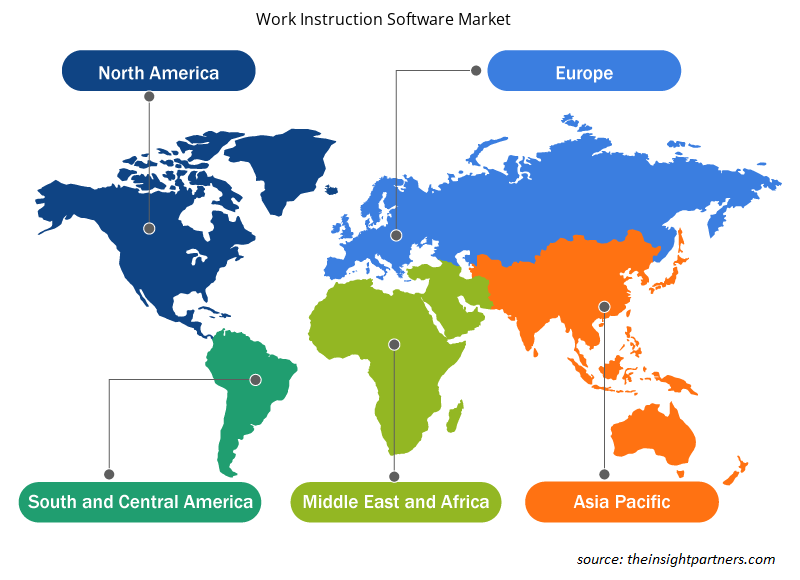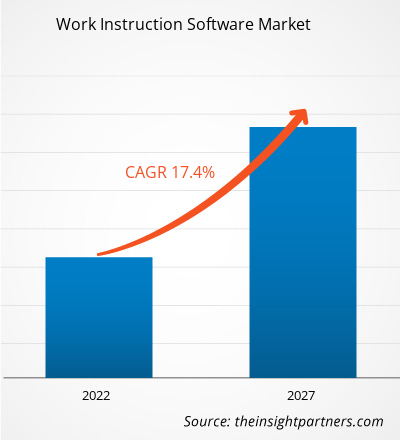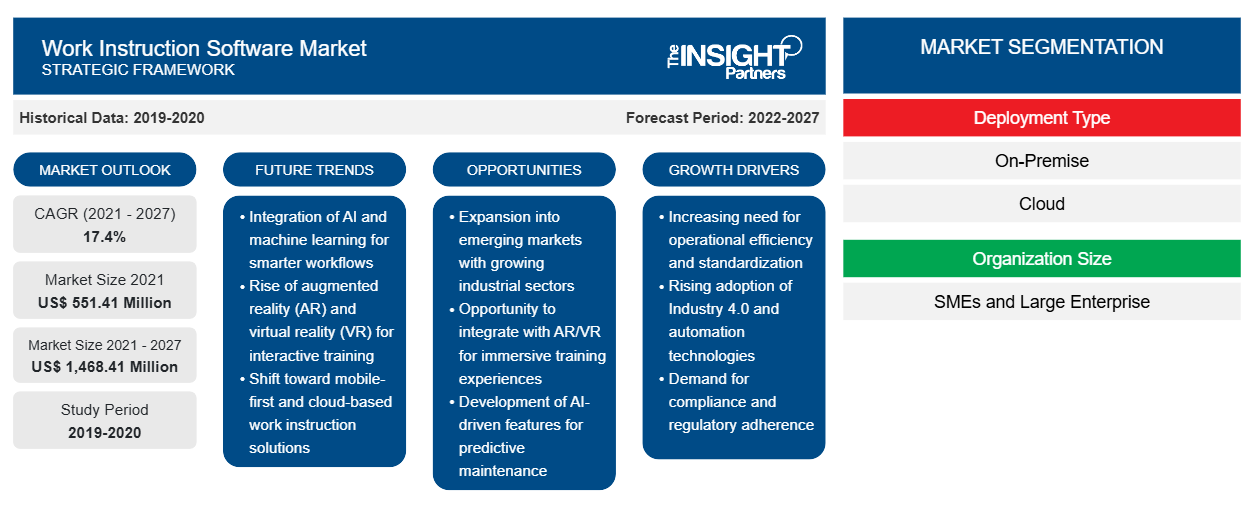من المتوقع أن ينمو سوق برامج تعليمات العمل من 551.41 مليون دولار أمريكي في عام 2021 إلى 1،468.41 مليون دولار أمريكي بحلول عام 2027. ومن المتوقع أن ينمو سوق برامج تعليمات العمل بمعدل نمو سنوي مركب قدره 17.4٪ خلال الفترة المتوقعة من 2020 إلى 2027.
العامل الرئيسي الذي يحرك السوق هو التعقيدات التجارية والإنتاجية المتغيرة باستمرار. إن اعتماد عملية الإنتاج النموذجية المختلطة لتعزيز إنتاجية التصنيع في المنظمة بشكل عام يخلق الحاجة إلى التدريب والتطوير المعززين بين الموظفين. وبالتالي، فإن هذا يغذي اعتماد برامج تعليمات العمل في جميع أنحاء قطاع التصنيع. إن الحاجة إلى تدريب الموظفين لتحسين الإنتاجية تؤدي إلى اعتماد حلول متقدمة تقنيًا في جميع المؤسسات. إن التعقيد المتزايد في عملية العمل في جميع الصناعات مثل التصنيع والسيارات والرعاية الصحية وتجارة التجزئة يزيد من الطلب على تعليمات العمل بين الموظفين والعمال لأداء مهمتهم بشكل مستقل وفعال. على سبيل المثال، تقدم شركة Augmentir, Inc. منصة قوة عاملة متصلة تعمل بالذكاء الاصطناعي لمساعدة الموظفين في سير العمل الرقمي والتوجيه عن بُعد طوال عملية العمل.
لقد أصبح من الواضح مع انتشار جائحة كوفيد-19 في جميع أنحاء العالم أن القليل من الناس يستطيعون الإفلات من نطاقها، مما يفرض تحديات كبيرة على جميع الصناعات. ومع ذلك، فإن التطبيق الرئيسي للبرمجيات هو في قطاع التصنيع حيث يتم تطبيق نفس الشيء على تقديم التدريب للموظفين فيما يتعلق بتشغيل آلات معينة. وبالتالي، من المتوقع أن يؤثر إغلاق جميع وحدات التصنيع في كل من الدول المتقدمة والنامية سلبًا على نمو سوق برامج تعليمات العمل .
بناءً على نوع النشر، يتم تقسيم برامج تعليمات العمل إلى محلية وسحابية. ومن المتوقع أن تنمو الحلول المستندة إلى السحابة بأعلى معدل نمو سنوي مركب خلال فترة التنبؤ. وعلاوة على ذلك، يتم تقسيم سوق برامج تعليمات العمل بناءً على حجم المنظمة إلى الشركات الصغيرة والمتوسطة الحجم والمؤسسات الكبيرة. وتستحوذ الشركات الكبيرة على الحصة الكبرى في السوق. تم تقسيم السوق العالمية لبرامج تعليمات العمل إلى خمس مناطق رئيسية - أمريكا الشمالية وأوروبا ومنطقة آسيا والمحيط الهادئ والشرق الأوسط وأفريقيا وجنوب آسيا.
قم بتخصيص هذا التقرير ليناسب متطلباتك
ستحصل على تخصيص لأي تقرير - مجانًا - بما في ذلك أجزاء من هذا التقرير، أو تحليل على مستوى الدولة، وحزمة بيانات Excel، بالإضافة إلى الاستفادة من العروض والخصومات الرائعة للشركات الناشئة والجامعات
- احصل على أهم اتجاهات السوق الرئيسية لهذا التقرير.ستتضمن هذه العينة المجانية تحليلاً للبيانات، بدءًا من اتجاهات السوق وحتى التقديرات والتوقعات.
تعليمات العمل - رؤى سوق البرمجيات
تغيير ثقافة العمل في مختلف أنحاء المنظمة
إن الاتجاه المتزايد نحو إحضار الأجهزة الشخصية (BYOD) إلى جانب ثقافة العمل عن بعد في جميع المؤسسات وخاصة في الشركات الكبيرة يخلق الحاجة إلى حلول تعليمات العمل لضمان السير السلس بين المؤسسات. لقد أدت ثقافة العمل المرنة في المؤسسات إلى عدم وجود موظفين من مباني المكاتب، مما يتسبب في حدوث خلل في سير العمل وخاصة بالنسبة للموظفين المبتدئين الذين يحتاجون إلى مساعدة مستمرة للتعلم وتنفيذ الوظائف لتحقيق الأهداف. وبالتالي فإن دمج حلول تعليمات العمل عبر المؤسسات يمكّن أصحاب العمل من تعليم جميع الموظفين دون السماح للحاجز المادي بالتأثير على كفاءة الإنتاج.
رؤى السوق المستندة إلى نوع النشر
بناءً على نوع النشر، يتم تقسيم سوق برامج تعليمات العمل العالمية إلى نشر قائم على السحابة ونشر محلي. تشهد برامج تعليمات العمل القائمة على السحابة طلبًا مرتفعًا مقارنة ببرامج تعليمات العمل المحلية. يولد قطاع السحابة غالبية الطلب لأنه أقل تكلفة نسبيًا وبسبب البنية التحتية القوية للشبكة في البلدان المتقدمة. بالإضافة إلى ذلك، يركز بائعو برامج تعليمات العمل القائمة على السحابة بشكل كبير على تطوير تصحيح أمان عالي المستوى من أجل القضاء على خطر الهجوم الإلكتروني. هذا العامل يخلق أيضًا طلبًا كبيرًا من المستخدمين النهائيين، وبالتالي يقود سوق برامج تعليمات العمل.
رؤى السوق بناءً على حجم المنظمة
بناءً على حجم المنظمة، يتم تقسيم سوق برامج تعليمات العمل إلى الشركات الصغيرة والمتوسطة الحجم والمؤسسات الكبيرة. إن الاستثمار المتزايد في البنية الأساسية للتصنيع في كل من الدول المتقدمة والنامية يعمل بشكل كبير على دفع الطلب على برامج تعليمات العمل بين الشركات الصغيرة والمتوسطة الحجم.
يركز اللاعبون العاملون في سوق برامج تعليمات العمل على الاستراتيجيات، مثل مبادرات السوق، والاستحواذات، وإطلاق المنتجات، للحفاظ على مواقعهم في سوق برامج تعليمات العمل. فيما يلي بعض التطورات التي قام بها اللاعبون الرئيسيون في سوق برامج تعليمات العمل:
في أبريل 2020، دخلت SwipeGuide في شراكة مع XMReality لنشر تعليمات العمل الرقمية باستخدام الدعم عن بعد.
في أكتوبر 2019، قامت شركة Georg Fischer Signet بتنفيذ AssemblyX من شركة Lifecycle Technology Ltd لأدوات العمل.
رؤى إقليمية حول سوق برامج تعليمات العمل
لقد قام المحللون في Insight Partners بشرح الاتجاهات والعوامل الإقليمية المؤثرة على سوق برامج تعليم العمل طوال فترة التوقعات بشكل شامل. يناقش هذا القسم أيضًا قطاعات سوق برامج تعليم العمل والجغرافيا في جميع أنحاء أمريكا الشمالية وأوروبا ومنطقة آسيا والمحيط الهادئ والشرق الأوسط وأفريقيا وأمريكا الجنوبية والوسطى.

- احصل على البيانات الإقليمية المحددة لسوق برامج تعليم العمل
نطاق تقرير سوق برامج تعليمات العمل
| سمة التقرير | تفاصيل |
|---|---|
| حجم السوق في عام 2021 | 551.41 مليون دولار أمريكي |
| حجم السوق بحلول عام 2027 | 1,468.41 مليون دولار أمريكي |
| معدل النمو السنوي المركب العالمي (2021 - 2027) | 17.4% |
| البيانات التاريخية | 2019-2020 |
| فترة التنبؤ | 2022-2027 |
| القطاعات المغطاة | حسب نوع النشر
|
| المناطق والدول المغطاة | أمريكا الشمالية
|
| قادة السوق وملفات تعريف الشركات الرئيسية |
|
كثافة اللاعبين في سوق برمجيات تعليمات العمل: فهم تأثيرها على ديناميكيات الأعمال
يشهد سوق برامج تعليمات العمل نموًا سريعًا، مدفوعًا بالطلب المتزايد من المستخدم النهائي بسبب عوامل مثل تفضيلات المستهلك المتطورة والتقدم التكنولوجي والوعي المتزايد بفوائد المنتج. ومع ارتفاع الطلب، تعمل الشركات على توسيع عروضها والابتكار لتلبية احتياجات المستهلكين والاستفادة من الاتجاهات الناشئة، مما يؤدي إلى زيادة نمو السوق.
تشير كثافة اللاعبين في السوق إلى توزيع الشركات أو المؤسسات العاملة في سوق أو صناعة معينة. وهي تشير إلى عدد المنافسين (اللاعبين في السوق) الموجودين في مساحة سوق معينة نسبة إلى حجمها أو قيمتها السوقية الإجمالية.
الشركات الرئيسية العاملة في سوق برمجيات تعليمات العمل هي:
- شركة لايف سايكل للتكنولوجيا المحدودة
- إدارة المعرفة في Livepro
- دليل التمرير
- سكرين ستيبس، ذ.م.م
- شركة مشاركة المعرفة البصرية المحدودة
إخلاء المسؤولية : الشركات المذكورة أعلاه ليست مرتبة بأي ترتيب معين.

- احصل على نظرة عامة على أهم اللاعبين الرئيسيين في سوق برامج تعليمات العمل
سوق برامج تعليمات العمل – حسب نوع النشر
- سحاب
- في الموقع
سوق برامج تعليمات العمل – حسب حجم المنظمة
- الشركات الكبيرة
- الشركات الصغيرة والمتوسطة
سوق برمجيات تعليمات العمل – حسب المنطقة الجغرافية
- أمريكا الشمالية
- نحن
- كندا
- المكسيك
- أوروبا
- فرنسا
- ألمانيا
- روسيا
- المملكة المتحدة
- إيطاليا
- بقية أوروبا
- آسيا والمحيط الهادئ (APAC)
- الصين
- الهند
- اليابان
- أستراليا
- كوريا الجنوبية
- بقية منطقة آسيا والمحيط الهادئ
- الشرق الأوسط وأفريقيا
- المملكة العربية السعودية
- الامارات العربية المتحدة
- جنوب أفريقيا
- باقي منطقة الشرق الأوسط وأفريقيا
- سام
- البرازيل
- الأرجنتين
- بقية سام
تعليمات العمل سوق البرمجيات – نبذة عن الشركة
- دوزوكي
- أنظمة eFlex
- سداسي AB
- شركة لايف سايكل للتكنولوجيا المحدودة
- إدارة المعرفة في Livepro
- برنامج أوبتيل
- سكرين ستيبس، ذ.م.م
- دليل التمرير
- شركة مشاركة المعرفة البصرية المحدودة
- زابتيك
- التحليل التاريخي (سنتان)، سنة الأساس، التوقعات (7 سنوات) مع معدل النمو السنوي المركب
- تحليل PEST و SWOT
- حجم السوق والقيمة / الحجم - عالمي، إقليمي، بلد
- الصناعة والمنافسة
- مجموعة بيانات إكسل
التقارير الحديثة
تقارير ذات صلة
شهادات العملاء
سبب الشراء
- اتخاذ قرارات مدروسة
- فهم ديناميكيات السوق
- تحليل المنافسة
- رؤى العملاء
- توقعات السوق
- تخفيف المخاطر
- التخطيط الاستراتيجي
- مبررات الاستثمار
- تحديد الأسواق الناشئة
- تحسين استراتيجيات التسويق
- تعزيز الكفاءة التشغيلية
- مواكبة التوجهات التنظيمية





















 احصل على عينة مجانية ل - سوق برمجيات تعليمات العمل
احصل على عينة مجانية ل - سوق برمجيات تعليمات العمل